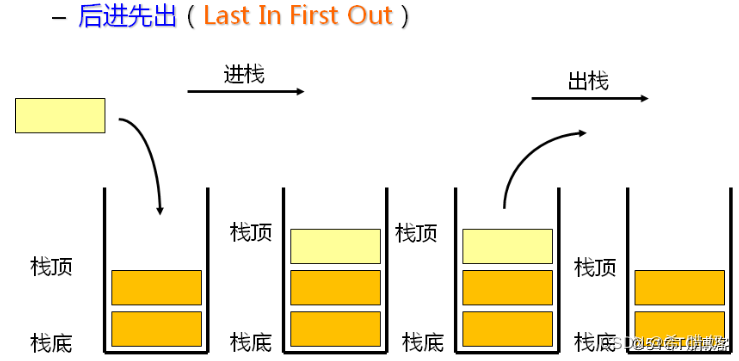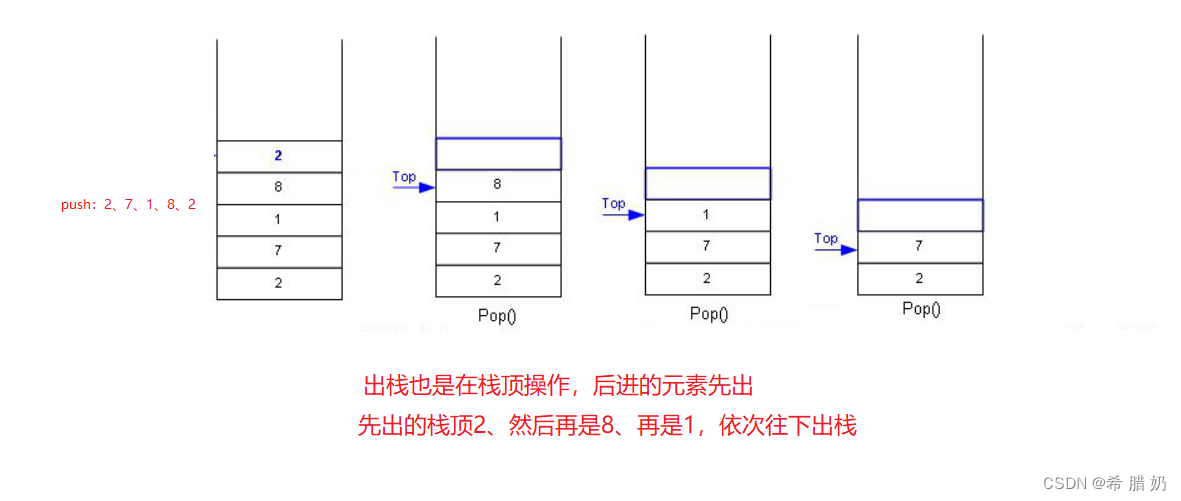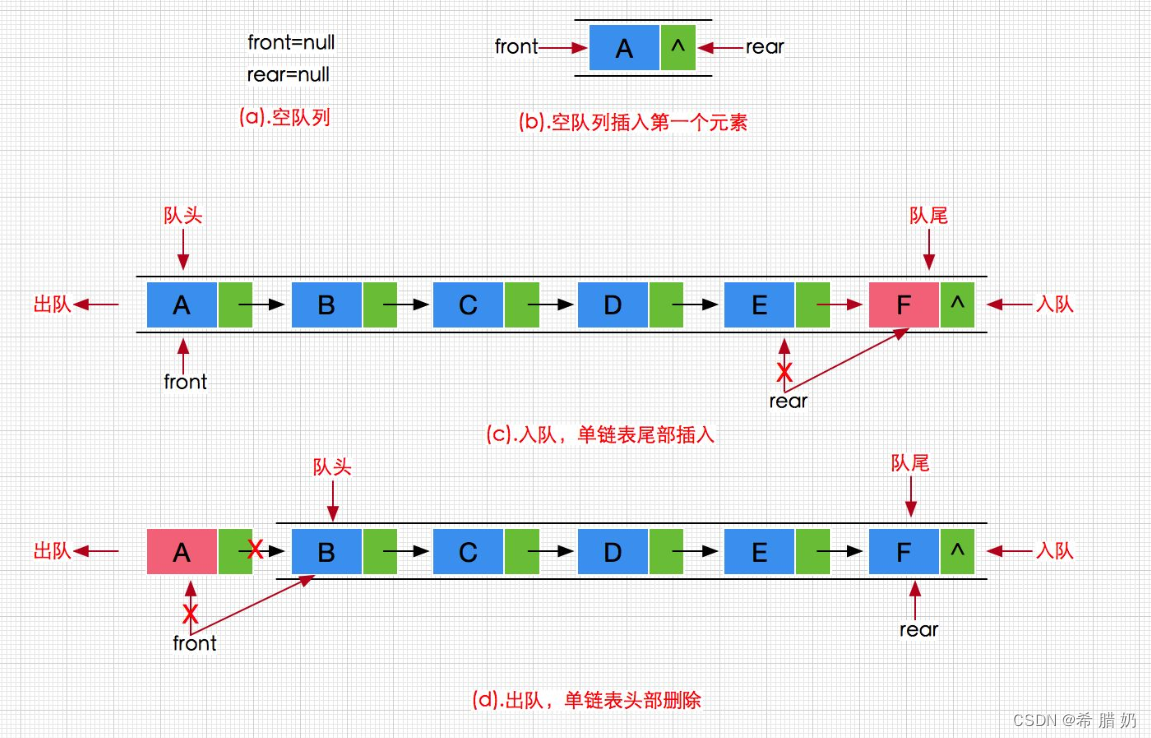文章目录
- 前言
- 一、栈
- 1、栈的基本概念
- 2、栈的实现(数组实现)
- 3、栈的基本操作
- 3.1 栈的结构设计
- 3.2 栈常见的基本函数接口
- 4、栈的实现
- 4.1 初始化栈
- 4.2 栈的销毁
- 4.3 入栈
- 4.4 出栈
- 4.5 判空
- 4.6 长度
- 4.7 获取栈顶元素
- 完整代码
- Stack.h
- Stack.c
- Test.c
- 二、队列
- 1、队列的结构及概念
- 2、队列的实现(单链表实现)
- 1、队列的链式结构设计
- 2、常用的功能接口
- 2.1、初始化队列
- 2.2、销毁队列
- 2.3、入队列
- 2.4、出队列
- 2.5、获取队列头部元素
- 2.6、获取队列尾部元素
- 2.7、判空
- 2.8、获取有效元素个数
- 完整代码
- Queue.h
- Queue.c
- Test.c
前言

一、栈
1、栈的基本概念
栈:一种特殊的线性表,其只允许在固定的一端进行插入和删除元素操作。进行数据插入和删除操作的一端称为栈顶,另一端称为栈底。栈中的数据元素遵守后进先出LIFO(Last In First Out)的原则
压栈:栈的插入操作叫做进栈/压栈/入栈,入数据在栈顶。
出栈:栈的删除操作叫做出栈。出数据也在栈顶

2、栈的实现(数组实现)
栈的实现一般可以使用数组或者链表实现,相对而言数组的结构实现更优一些。因为数组在尾上插入数据的代价比较小

3、栈的基本操作
压栈:栈的插入操作,也叫进栈/入栈/压栈,在栈顶进行数据操作。
出栈:栈的删除操作,也是在栈顶进行数据删除的。
3.1 栈的结构设计
typedef int STDataType;//方便修改类型
typedef struct Stack
{STDataType* a;int top;int capacity;
}ST;
3.2 栈常见的基本函数接口
//初始化
void STInit(ST* pst);
//销毁栈
void STDestroy(ST* pst);
//入栈
void STPush(ST* pst, STDataType x);
//出栈
void STPop(ST* pst);
//判空
bool STEmpty(ST* pst);
//长度
int STSize(ST* pst);
//栈顶
STDataType STTop(ST* pst);
4、栈的实现
4.1 初始化栈
//初始化
void STInit(ST* pst)
{assert(pst);pst->a = NULL;pst->top = 0;//指向栈顶下一个元素,若等于-1则指向栈顶元素,两种任选pst->capacity = 0;
}
4.2 栈的销毁
//销毁栈
void STDestroy(ST* pst)
{assert(pst);tree(pst->a);pst->a = NULL;pst->top = 0;pst->capacity = 0;
}
4.3 入栈

代码:
void STPush(ST* pst, STDataType x)
{assert(pst);//判断栈是否已满,满了就扩容if (pst->top == pst->capacity){//使用三目运算符进行第一次开辟空间和后续扩容空间int newcapacity = pst->capacity == 0 ? 4 : pst->capacity * 2;STDataType* tmp = (STDataType*)realloc(pst->a, sizeof(STDataType) * newcapacity);//判断realloc是否开辟成功if (tmp == NULL){perror("realloc fail");return;}//赋新值pst->a = tmp;pst->capacity = newcapacity;}//插入pst->a[pst->top] = x;pst->top++;
}
4.4 出栈

代码:
//出栈
void STPop(ST* pst)
{assert(pst);assert(pst->top > 0);pst->top--;
}
4.5 判空
//判空
bool STEmpty(ST* pst)
{assert(pst); //返回值为0为假,非零为真return pst->top == 0;
}4.6 长度
//长度
int STSize(ST* pst)
{assert(pst);return pst->top;
}
4.7 获取栈顶元素
注意:若栈顶指针初始化为pst->top = 0,即栈顶指针指向栈顶元素的下一个位置,则入栈操作变为pst->a[pst->top++],出栈操作为pst->a[- -pst->top]。因为栈顶指针若初始化为 0 时,则栈顶指针始终指向顺序栈将要入栈的位置,也就是栈顶指针的下标就是入栈元素的下标。
//栈顶
STDataType STTop(ST* pst)
{assert(pst);return pst->a[pst->top - 1];
}
完整代码
Stack.h
#include<stdio.h>
#include<assert.h>
#include<stdlib.h>
#include<stdbool.h>typedef int STDataType;
typedef struct Stack
{STDataType* a;int top;int capacity;
}ST;//初始化
void STInit(ST* pst);
//销毁栈
void STDestroy(ST* pst);
//入栈
void STPush(ST* pst, STDataType x);
//出栈
void STPop(ST* pst);
//判空
bool STEmpty(ST* pst);
//长度
int STSize(ST* pst);
//栈顶
STDataType STTop(ST* pst);
Stack.c
#include"Stack.h"//初始化
void STInit(ST* pst)
{assert(pst);pst->a = NULL;pst->top = 0;//指向栈顶下一个元素pst->capacity = 0;
}
//销毁栈
void STDestroy(ST* pst)
{assert(pst);tree(pst->a);pst->a = NULL;pst->top = 0;pst->capacity = 0;
}
//入栈
void STPush(ST* pst, STDataType x)
{assert(pst);if (pst->top == pst->capacity){int newcapacity = pst->capacity == 0 ? 4 : pst->capacity * 2;STDataType* tmp = (STDataType*)realloc(pst->a, sizeof(STDataType) * newcapacity);if (tmp == NULL){perror("realloc fail");return;}pst->capacity = newcapacity;pst->a = tmp;}pst->a[pst->top] = x;pst->top++;
}
//出栈
void STPop(ST* pst)
{assert(pst);assert(pst->top > 0);pst->top--;
}
//判空
bool STEmpty(ST* pst)
{assert(pst);return pst->top == 0;
}
//长度
int STSize(ST* pst)
{assert(pst);return pst->top;
}
//栈顶
STDataType STTop(ST* pst)
{assert(pst);return pst->a[pst->top - 1];
}
Test.c
#include"Stack.h"int main()
{ST st;//初始化STInit(&st);//插入+删除STPush(&st, 1);STPush(&st, 2);STPush(&st, 3);STPush(&st, 4);STPush(&st, 5);STPop(&st);STPop(&st);//长度STSize(&st);//栈顶STTop(&st);//销毁STDestroy(&st);return 0;
}二、队列
1、队列的结构及概念
队列:只允许在一端进行插入数据操作,在另一端进行删除数据操作的特殊线性表,队列具有先进先出FIFO(First In First Out) 入队列:进行插入操作的一端称为队尾 出队列:进行删除操作的一端称为队头

2、队列的实现(单链表实现)
队列也可以数组和链表的结构实现,使用链表的结构实现更优一些,因为如果使用数组的结构,出队列在数组头上出数据,效率会比较低。

下面话不多说,直接开始代码实现
1、队列的链式结构设计
//链式结构 表示队列
typedef int QDataType;
typedef struct QueueNode
{struct QueueNode* next;QDataType val;
}QNode;
//队列的结构
typedef struct Queue
{QNode* phead;QNode* ptail;int size;
}Queue;
2、常用的功能接口
//初始化
void QueueInit(Queue* pq);
//销毁队列
void QueueDeatroy(Queue* pq);
//队尾入列
void QueuePush(Queue* pq, QDataType x);
//队头出列
void QueuePop(Queue* pq);
//获取队列头部元素
QDataType QueueFront(Queue* pq);
//获取队列尾部元素
QDataType QueueBack(Queue* pq);
//检测队列是否为空,如果为空返回非零结果,如果非空返回0
bool QueueEmpty(Queue* pq);
//获取队列中有效元素个数
int QueueSize(Queue* pq);
2.1、初始化队列
只需要将头尾指针都指向空即可,元素个数为零
//初始化
void QueueInit(Queue* pq)
{assert(pq);pq->phead = NULL;pq->ptail = NULL;pq->size = 0;
}
2.2、销毁队列
遍历链表,从头到尾依次删除结点,最后将头尾指针指向空,元素个数为0。
//销毁队列
void QueueDeatroy(Queue* pq)
{assert(pq);QNode* cur = pq->phead;while (cur){QNode* next = cur->next;free(cur);cur = next;}pq->phead = NULL;pq->ptail = NULL;pq->size = 0;}
2.3、入队列
创建新节点,若队列为空,则将头指针和尾指针都指向新创建的节点,若不为空,则尾插,因为是链式存储,所以和单链表的尾插一样,将尾指针的next指向该节点,再把该节点设为新的尾节点
void QueuePush(Queue* pq, QDataType x)
{assert(pq);QNode* newnode = (QNode*)malloc(sizeof(QNode));if (newnode == NULL){perror("malloc fail");return;}newnode->val = x;newnode->next = NULL;if (pq->ptail == NULL){pq->ptail = pq->phead = newnode;}else{pq->ptail->next = newnode;pq->ptail = newnode;}pq->size++;
}
2.4、出队列
注意:出列要考虑队列是空还是只有一个结点又或者有多个结点,为空则在代码第一步就报错,若只有一个结点,则直接删除该结点,并将头尾俩指针指向空,若不止一个结点,可以创建一个临时指针来记录当前头指针,然后尾指针往后遍历,再free掉创建的临时指针,并置空
void QueuePop(Queue* pq)
{assert(pq);assert(pq->phead);QNode* del = pq->phead;pq->phead = pq->phead->next;free(del);del = NULL;if (pq->phead == NULL)pq->ptail = NULL;pq->size--;
}
2.5、获取队列头部元素
断言,然后直接返回队头指针指向的节点元素
//获取队列头部元素
QDataType QueueFront(Queue* pq)
{assert(pq);assert(pq->phead);return pq->phead->val;
}
2.6、获取队列尾部元素
也是一样的,直接返回队尾指针指向的节点元素
//获取队列尾部元素
QDataType QueueBack(Queue* pq)
{assert(pq);assert(pq->phead);return pq->ptail->val;
}
2.7、判空
检测队列是否为空,如果为空返回非零结果,如果非空返回0
bool QueueEmpty(Queue* pq)
{assert(pq);return pq->phead == NULL;
}
2.8、获取有效元素个数
//获取队列中有效元素个数
int QueueSize(Queue* pq)
{assert(pq);return pq->size;
}
完整代码
Queue.h
#include<stdio.h>
#include<stdlib.h>
#include<assert.h>
#include<stdbool.h>//链式结构 表示队列
typedef int QDataType;
typedef struct QueueNode
{struct QueueNode* next;QDataType val;
}QNode;
//队列的结构
typedef struct Queue
{QNode* phead;QNode* ptail;int size;
}Queue;
//初始化
void QueueInit(Queue* pq);
//销毁队列
void QueueDeatroy(Queue* pq);
//队尾入列
void QueuePush(Queue* pq, QDataType x);
//队头出列
void QueuePop(Queue* pq);
//获取队列头部元素
QDataType QueueFront(Queue* pq);
//获取队列尾部元素
QDataType QueueBack(Queue* pq);
//检测队列是否为空,如果为空返回非零结果,如果非空返回0
bool QueueEmpty(Queue* pq);
//获取队列中有效元素个数
int QueueSize(Queue* pq);
Queue.c
#include"Queue.h"//初始化
void QueueInit(Queue* pq)
{assert(pq);pq->phead = NULL;pq->ptail = NULL;pq->size = 0;
}
//销毁队列
void QueueDeatroy(Queue* pq)
{assert(pq);QNode* cur = pq->phead;while (cur){QNode* next = cur->next;free(cur);cur = next;}pq->phead = NULL;pq->ptail = NULL;pq->size = 0;}
//队尾入列
void QueuePush(Queue* pq, QDataType x)
{assert(pq);QNode* newnode = (QNode*)malloc(sizeof(QNode));if (newnode == NULL){perror("malloc fail");exit(-1);}newnode->next = NULL;newnode->val = x;if (pq->ptail == NULL){pq->phead = pq->ptail = newnode;}else{//现在newnode是新的尾结点pq->ptail->next = newnode;pq->ptail = newnode;}pq->size++;
}
//队头出列
void QueuePop(Queue* pq)
{assert(pq);assert(pq->phead); //保存当前节点QNode* tmp = pq->phead;//phead往下走pq->phead = pq->phead->next;free(tmp);tmp = NULL;if (pq->phead = NULL){pq->ptail = NULL;}pq->size--;
}
//获取队列头部元素
QDataType QueueFront(Queue* pq)
{assert(pq);assert(pq->phead);return pq->phead->val;
}
//获取队列尾部元素
QDataType QueueBack(Queue* pq)
{assert(pq);assert(pq->phead);return pq->ptail;
}
//检测队列是否为空,如果为空返回非零结果,如果非空返回0
bool QueueEmpty(Queue* pq)
{assert(pq);return pq->phead == NULL;
}
//获取队列中有效元素个数
int QueueSize(Queue* pq)
{assert(pq);return pq->size;
}
Test.c
#include"Queue.h"int main()
{Queue q;QueueInit(&q);QueuePush(&q, 1);QueuePush(&q, 2);QueuePush(&q, 3);while (!QueueEmpty(&q)){printf("%d ", QueueFront(&q));QueuePop(&q);}QueueDeatroy(&q);return 0;}






)
)

 在 .NET Core 中是如何工作的?)




)
数组和函数实践:扫雷游戏)




分布)